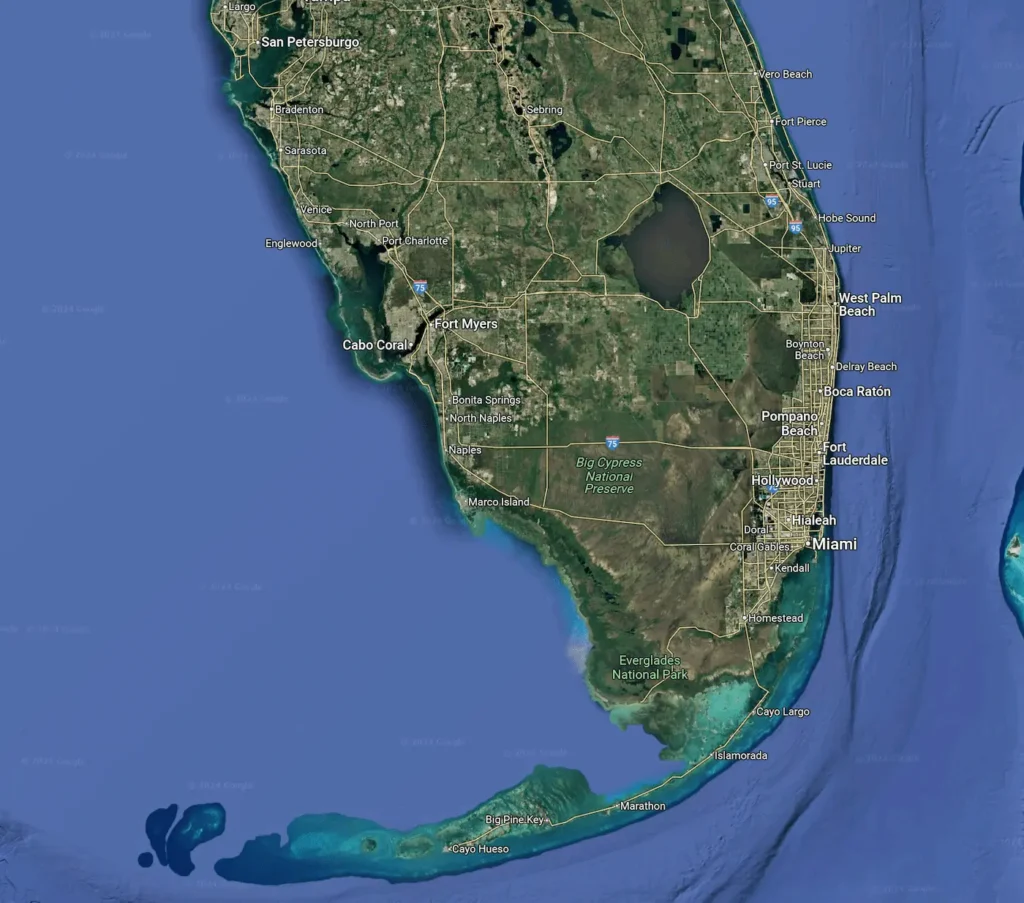|
Getting your Trinity Audio player ready... |
Tabla de Contenido/ Table of Contents
- 1 The Sinking of Buildings in Miami Beach: What Is the County Administration Doing, and What Comes Next?
- 2 Key Findings of the Study
- 3 What Is the County Administration Doing?
- 4 Actions to Be Taken: Future Proposals
- 5 Economic and Financial Implications
- 6 Frequently Asked Questions (FAQs)
- 6.1 1. Is it a fact that buildings are sinking in Miami-Dade?
- 6.2 2. Which areas are most affected?
- 6.3 3. Which buildings are affected?
- 6.4 4. What measures are currently being taken?
- 6.5 5. What actions are planned for the future?
- 6.6 6. What are the economic implications of this issue?
- 6.7 7. Will construction on Miami’s beaches continue?
- 7 Conclusion: A Future at Risk
The Sinking of Buildings in Miami Beach: What Is the County Administration Doing, and What Comes Next?
The recent study conducted by the University of Miami, led by Farzaneh Aziz Zanjani and Falk Amelung, has revealed a concerning phenomenon: dozens of luxury buildings and hotels on the barrier islands of Miami-Dade County show clear signs of progressive sinking. Measurements taken between 2016 and 2023 using InSAR (Interferometric Synthetic Aperture Radar) technology document vertical displacements ranging from 2 to 8 cm, mostly linked to new construction activities. These findings raise alarm due to the deterioration of infrastructure and the significant economic and public safety implications.
Despite the evidence, the construction of luxury high-rises continues with limited restrictions, sparking questions about the current and future actions of the Miami-Dade County administration.
Key Findings of the Study
The study provides a clear picture of the structural deterioration facing buildings in Miami Beach, Surfside, and Sunny Isles Beach, revealing:
- Affected Buildings: A total of 35 structures exhibit sinking between 2 and 8 cm during the study period.
- Most Affected Areas:
- Sunny Isles Beach: 70% of recent constructions show significant sinking.
- Surfside and Bal Harbour: Moderate levels of sinking compared to Sunny Isles Beach.
- Miami Beach: Only two buildings show minor signs of displacement.
- Iconic Buildings Impacted:
- Porsche Design Tower: Over 10 cm of sinking from 2016 to 2021.
- Ritz-Carlton Residences: Up to 5 cm of sinking within four years.
- Surf Club Towers and Faena House: Continuous, gradual sinking patterns.
The sinking is correlated with nearby construction and the presence of sand layers within the limestone substrate. Vibrations, tidal flows, and groundwater pumping during construction phases accelerate this process.
List of All Studied Areas, Studied Buildings, Their Construction Date, and the Measured Magnitude of Subsidence:
Studied Areas
- Sunny Isles Beach (North, Central, and South)
- Bal Harbor
- Surfside
- Miami Beach
Studied Buildings with Construction Dates and Measured Subsidence
| Building | Area | Construction Date | Subsidence (cm) |
|---|---|---|---|
| Ocean III | Sunny Isles Beach North | ~2003 | 4 cm |
| Bentley Residence | Sunny Isles Beach North | ~2020 (project) | 4 cm |
| Regalia | Sunny Isles Beach North | ~2014 | 2–2.5 cm |
| Ocean II | Sunny Isles Beach North | ~2000 | 2–2.5 cm |
| Marenas Beach Resort | Sunny Isles Beach North | ~2004 | 2–2.5 cm |
| Armani Casa | Sunny Isles Beach North | ~2019 | 4 cm |
| Millennium Condo | Sunny Isles Beach North | ~1999 | 3 cm |
| Porsche Design Tower | Sunny Isles Beach North | ~2017 | 10+ cm |
| Jade Ocean Condos | Sunny Isles Beach Central | ~2009 | 4–5 cm |
| Chateau Beach Residences | Sunny Isles Beach Central | ~2015 | 4–5 cm |
| Jade Beach Condos | Sunny Isles Beach Central | ~2008 | 3 cm |
| Muse Residences | Sunny Isles Beach Central | ~2018 | 2 cm |
| Trump International Beach Resort | Sunny Isles Beach Central | ~2003 | 3 cm |
| Ritz-Carlton Residences | Sunny Isles Beach South | ~2019 | 5 cm |
| Trump Tower III | Sunny Isles Beach South | ~2010 | 4 cm |
| Surf Club Towers | Surfside | ~2016 | 3–4 cm |
| Oceana Complex | Bal Harbor | ~2016 | 4.5 cm |
| Fendi Chateau Residence | Surfside | ~2016 | 1–1.5 cm |
| Marbella Condominium | Surfside | ~1970s | 1–1.5 cm |
| Carlisle on the Beach | Surfside | ~1970s | 1–1.5 cm |
| Arte Condominium | Surfside | ~2019 | ~3 cm |
| 87 Park Tower | Surfside | ~2019 | ~3 cm |
| L’Atelier Condominium | Miami Beach | ~2017 | 1–1.5 cm |
| Faena House | Miami Beach | ~2015 | 1 cm |
Summary of the Observed Phenomenon
- Subsidence Magnitude: Ranges from 2 to 8 cm vertically, with extreme cases exceeding 10 cm (Porsche Design Tower).
- Primary Cause: Construction-induced subsidence and vibrations, particularly affecting sand layers interbedded within limestone.
- Temporal Distribution: Subsidence observed between 2016 and 2023, with some cases showing temporal acceleration due to nearby construction.


What Is the County Administration Doing?
Faced with these findings, the administration of Miami-Dade County, led by Mayor Daniella Levine Cava, has begun implementing initial measures to mitigate the risks associated with building subsidence. However, these efforts remain limited due to pressures from the real estate market and the absence of stringent regulations.
Current Measures:
- Monitoring with Satellite Technology:
- Tools such as InSAR are being implemented to monitor displacement in critical buildings.
- The University of Miami’s study serves as a starting point for ongoing surveillance.
- Mandatory Geotechnical Assessments:
- As of 2024, developers are required to conduct extensive geotechnical studies before obtaining construction permits.
- These studies will assess the presence of sand layers interbedded in limestone and the risk of prolonged subsidence.
- Infrastructure Inspections:
- More frequent inspections are being carried out on buildings constructed before 2014.
- Buildings showing accelerated sinking will be required to undergo preventive reinforcement.
- Construction Restrictions:
- Temporary limits on large-scale projects are being considered in particularly vulnerable areas like Sunny Isles Beach and Surfside.
Actions to Be Taken: Future Proposals
The county must adopt more proactive and comprehensive measures to ensure resident safety and protect the local economy:
- Implement a Continuous Monitoring Program:
- Create a centralized monitoring system using InSAR and advanced technology like TerraSAR-X to track building movement.
- Establish Risk Zones:
- Identify areas with a high concentration of sand layers and unstable subsurface to limit future construction.
- Revise Building Codes:
- Update construction regulations to mandate reinforced foundations and practices that minimize vibrations during construction.
- Mitigate Environmental Impacts:
- Restrict groundwater pumping and evaluate the impact of tidal flows and stormwater injections in construction zones.
- Coastal Resilience Programs:
- Develop resilient infrastructure initiatives and advanced drainage systems to counteract rising sea levels and long-term subsidence.
Economic and Financial Implications
The sinking of buildings in Miami-Dade carries significant economic consequences:
- Loss of Property Value:
- Affected properties may lose their value, leading to millions in economic losses.
- Increased Maintenance Costs:
- Owners will face higher costs for ongoing inspections and structural reinforcements.
- Impact on Real Estate Market:
- Investor and buyer confidence in waterfront developments may decline.
- Higher Insurance Premiums:
- Insurance rates will rise due to the increased structural and environmental risks.
Frequently Asked Questions (FAQs)
1. Is it a fact that buildings are sinking in Miami-Dade?
Yes, the University of Miami study confirmed that 35 buildings are experiencing vertical displacement of 2 to 8 cm between 2016 and 2023.
2. Which areas are most affected?
The most impacted areas include Sunny Isles Beach (70% of recent buildings), Surfside, and parts of Miami Beach.
3. Which buildings are affected?
Some notable examples include:
- Porsche Design Tower: Over 10 cm of subsidence.
- Surf Club Towers and Ritz-Carlton Residences: Continuous subsidence.
- Faena House: Minor but gradual sinking.
4. What measures are currently being taken?
The county administration is:
- Monitoring buildings with InSAR technology.
- Requiring extensive geotechnical evaluations.
- Conducting frequent structural inspections.
5. What actions are planned for the future?
- Implementation of a continuous monitoring system.
- Creation of risk zones to limit construction.
- Revising building codes for stronger foundations.
6. What are the economic implications of this issue?
- Property devaluation for affected buildings.
- Rising insurance costs.
- Investor concerns impacting the real estate market.
7. Will construction on Miami’s beaches continue?
Construction continues for now, but future regulations are expected to be stricter, particularly in vulnerable areas.
Conclusion: A Future at Risk
The phenomenon of progressive subsidence along Miami-Dade’s beaches represents an unprecedented challenge for the region. While initial measures have been introduced, stronger and long-term solutions are needed to protect infrastructure, public safety, and the local economy.
Miami, a global icon of luxury and development, must balance growth with urban resilience to address the challenges posed by its coastal and geological environment.
Call to Action for Miami-Dade Residents!
Your participation makes a difference! Every effort counts, and by coming together as a community, we can face challenges and seize opportunities more effectively. We encourage you to:
- Attend meetings whenever possible.
- Share information with friends, family, and neighbors.
- Join local groups or committees working in areas of your interest.
- Stay informed about ongoing initiatives and projects.
By doing so, you will not only improve your immediate surroundings but also contribute to the legacy we will leave for future generations. Building a more prosperous, inclusive, and sustainable Miami-Dade depends on all of us.
Want more post like this?
Head over to our homepage for the latest updates from South Florida and beyond:











